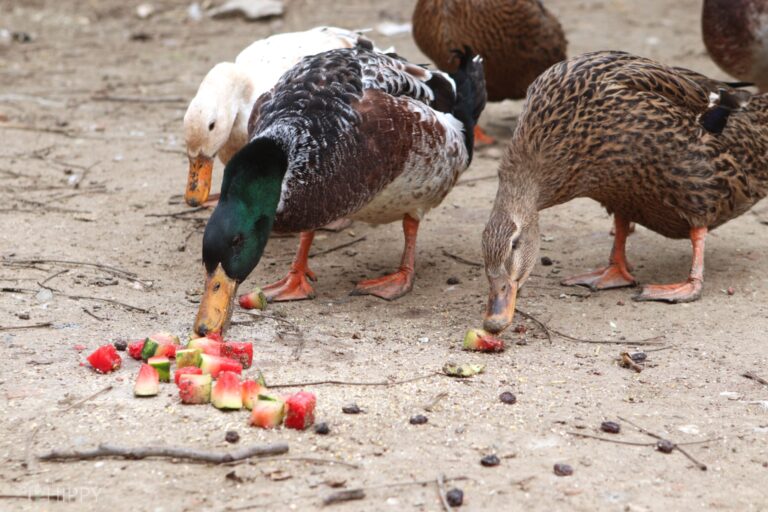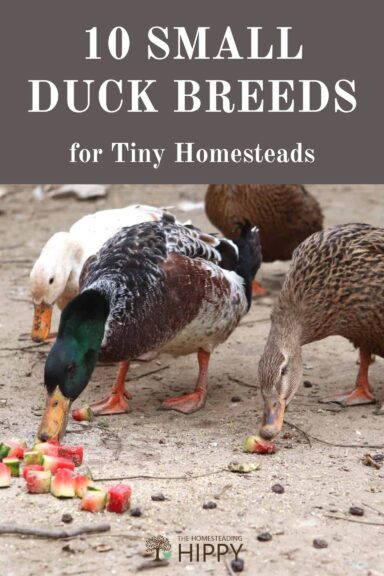One of the biggest limiting factors when it comes to keeping livestock of any kind is space, and for some homesteaders, even when you look to a truly small species like ducks you still might not have the room they require in order to thrive and stay healthy. It can be frustrating, even heartbreaking!
But if you are pressed for space you don’t have to despair; you just need a smaller duck that needs less room! And luckily there are plenty of domestic breeds out there that will fit the bill. Whether you want entertaining pets, plenty of eggs, or even meat you can still have it even if space is at a premium.
If you’ve got a tiny homestead keep reading and I’ll tell you about 10 perfect small duck breeds that will do just fine.

Mallard Duck
Mallards are some of the most common ducks in the world, and certainly the most common ones in North America. And to be perfectly clear, there are wild and domestic mallards, and physically the two tend to be quite different.
Domestic Mallards are definitely a smaller breed, though they tend to be heavier than their wild cousins, weighing up to three and a half pounds.
Kept for both eggs and meat, you can have a sizable flock in a relatively small space as long as they have a reasonably sized pool to dip and bathe in. A large kiddie pool is more than enough for six or seven ducks!
Even though they’re a trusty utility breed despite their small size, plenty of keepers own them for their gorgeous good looks and excellent health; they are really easy to take care of!
Khaki Campbell Duck
One of the most famous and beloved domestic ducks in North America and around the world, the Khaki Campbell is noteworthy for being the most prolific layer there is: many hens will lay up to 300 eggs a year, and plenty will lay even more than that!
This makes them one of the very best breeds to keep if you plan on getting lots of eggs, but since they grow to a sizable weight of around 5 pounds they can also be a good meat-producing breed.
Although they are one of the larger breeds on our list, Khaki Campbells tend to be skittish but content even with relatively little room to move around, and they tolerate confinement well.
Despite their relative size, this makes them an intelligent choice for a small homestead, especially if you want a highly productive flock.
Carolina Wood Duck
Probably the single most gorgeous duck on our list, the Carolina Wood Duck (Aix sponsa) shows off incredible plumage ranging from a speckled brick red to a lovely striated fawn, black and white stripes, emerald green, red, purple, and more.
This is reason enough to own them, for most folks! And it’s probably the only reason that you’ll own them: as a wild duck that can be bought and raised in a domestic setting from hatcheries and breeders, they don’t produce nearly as many eggs and tend to be very broody.
But, like the name suggests, these are perching ducks that are totally happy spending much of their time on land, and that means they need very little water access by comparison – though they still need some as with all ducks in order to stay healthy.
This is another genuinely tiny breed, and even the largest male will rarely break the 2-pound mark. You’ll have to spend more for the pleasure of owning these gorgeous birds, and you must take precautions to make sure they don’t fly away, but they are easily kept even on a small property.
Mini Australian Spotted
Don’t let the name deceive you; these gorgeous, tiny 2-pound ducks were actually developed in the United States from various Pacific Rim domestic breeds.
With a speckled, ashy tan body, distinctive eyeliner markings, and a blue or green head, they are definitely lookers! Sadly, the breed is rare today and growing rarer all the time.
They’re also reasonably productive for such a small variety, with females laying multicolored eggs at a rate of about 100 a year, though some will lay more or less.
But be warned, females tend to be broody, and this can definitely put the brakes on egg production. Potentially worse for some of us, this is one of the noisier ducks out there, but owners report they are friendly and very easy to handle.
Welsh Harlequin Duck
A gorgeous Welsh duck, just like the name suggests, the Welsh Harlequin (Histrionicus histrionicus) was developed in the middle of the 20th century, but was only accepted by the APA in the early 2000s.
This is another modestly sized breed that is a supreme layer, routinely producing upwards of 225 eggs each and every year.
Calm, docile, and independent, they make great foragers and tolerate small spaces well as long as they aren’t overcrowded.
Like the Khaki Campbell, this is a medium-small breed that can grow up to 5 pounds or a little bit larger. And just like the Campbell, it’s one of the most productive ducks in their size category and still totally suitable for smaller parcels.
Call Duck
A truly tiny domestic breed with a really interesting purpose, the call duck (Anas platyrhynchos domesticus) only weighs about 1 ½ pounds at most, and that’s in the case of males. Any females only weigh about a pound or a little bit more. They are truly pint-sized!
And they are adorable, with tight, smooth feathers and plump proportions that make them look like a living cartoon character.
Today, call ducks are a popular ornamental or backyard pet breed, but in the past, they were used as live decoys to draw in other ducks for hunters to shoot down. That’s where they got the name, Call, because they were said to call to other ducks! Kind of grim, but that’s the truth…
But, it also lets you know what to expect from this breed: they need very little room or water to swim in, they’re incredibly noisy and tend to sing out at all hours of the day and night, so be ready for that and think twice if you have neighbors nearby!
Magpie Duck
The magpie duck (Anas platyrhynchos domesticus), thankfully, won’t steal your belongings and other shiny objects unlike its namesake bird. They do, though, resemble them with a stark white coloration punctuated by a black cap on their head and charcoal gray saddle markings across their back and wings.
These ducks are charming, curious, and also a wonderful dual-use breed, producing a large carcass yield of meat and many eggs yearly, with 225 being average and some exceptional hens laying up to 300.
They also happen to be remarkably long-lived, with individuals in captivity and given good care reaching 12 years old and sometimes even beyond.
Hens are significantly smaller than males, usually weighing about 4 ½ pounds, but if you want drakes they can reach up to seven pounds!
Mini Silver Appleyard
A miniature version of the standard Silver Appleyard, this bantam variety is significantly smaller than its namesake, maxing out at around two and a half pounds.
But despite their tiny size, they’re one of the most productive egg-laying bantam breeds, with hens laying up to 275 medium, white eggs a year.
These gorgeous, glossy, speckled tan and green ducks are also remarkably active and good foragers. Normally, this would disqualify them from being kept in a small space, but they are diligent hunters and seem content even when they aren’t allowed to roam over large spaces.
They’re easy to satisfy, and combined with their high egg output, it makes them one of the very best bantams for homesteaders with limited space.
Black East Indie Duck
One of the most well-regarded true bantam breeds, The Black East Indie (Anas platyrhynchos domesticus) is an ancient breed indeed.
Although they’ve been in the US since the 18th century, their lineage stretches back hundreds of years and that’s just what we know; their exact origin remains unknown to this day.
But that’s enough with the history lesson, what can these ducks do for you? Well, if space is at a premium you’ll be happy to know that these little birds weigh anywhere from 1 ½ to just a hair over 2 pounds and that’s at the absolute most.
They also make wonderful pets and exhibition animals because of their calm, stoic temperament when they are raised with proper socialization, and they’re downright gorgeous thanks to their smoky brown, almost plum-colored feathers and iridescent green on their heads, wings, and tails.
Sadly, they aren’t great layers, and females will produce only 100 eggs yearly at the absolute most.
Indian Runner
One of the coolest and quirkiest ducks on our list, and anywhere as far as I’m concerned, the Indian runner (Anas platyrhynchos domesticus) is indeed a duck that likes to run. And I do mean run, not waddle!
These ducks stand upright, almost completely vertical, very much in the manner of a penguin and like penguins, they are flightless. But they make up for this lack of flight with remarkable ground speed…
They look a bit goofy cruising around your yard, and they still need water like all ducks, but despite this curious physiology, they’re surprisingly good egg layers, one of the very best in fact. Some Indian Runners hens can lay upwards of 300 eggs yearly, though they tend not to be productive for very long.
Note that hens tend to be quite a bit smaller than drakes, usually weighing right at 3 pounds or a little bit more. Drakes can be significantly heavier, right at 5 pounds.

Tim is a farm boy with vast experience on homesteads, and with survival and prepping. He lives a self-reliant lifestyle along with his aging mother in a quiet and very conservative little town in Ohio. He teaches folks about security, prepping and self-sufficiency not just through his witty writing, but also in person.
Find out more about Tim and the rest of the crew here.
